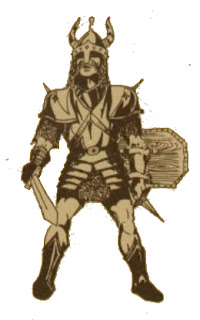 |
| Say what you want about LBB art, this has been my image of a fighter since 1976 |
- As a Hero or Superhero, he could engage fantastic foes on the "Fantasy Combat Table" (FCT from here on);
- As a Hero or Superhero, he could ONLY be engaged by foes on the FCT (Heroes may be ganged up on by at least 4 lesser foes, Superheroes require 8);
- Heroes never check morale, which I would translate as immune to non-magical fear and a saving throw bonus against magical fear;
- Heroes grant a +1 to the morale check of friendly troops. I would include followers in this, but not fellow PCs;
- Superheroes enjoy all of the above benefits, plus they cause all 1HD foes to check morale (save vs Fear) when the superhero approaches to within his charge distance.
That is actually a pretty impressive array of abilities. The problem lies in translating their implementation into LBB D&D.
- There's no FCT, so points the first two points just go by the boards;
- Naturally occurring fear isn't much of a thing, so being immune to it isn't either;
Those two points alone, if left unaddressed, strip away almost all of the fighting-man's niche protection. The cleric is the fighting-man's main competitor in this department, which I'll address in an upcoming post. Let's just say that the cleric stays close in combat ability per the "Alternative Combat Table" (ACT from here on), His HD and hp are almost identical, he can wear the same armor, his weapons do the same damage. All for a greatly reduced xp cost.
I do want to say this: morale can play a part in LBB gaming. What I'm driving at is that morale was one of the things that was assumed in the LBBs. As with many things, they were written with the assumption that they were being played by people that either already played Chainmail or at least played some form of wargame.
For many years, and through lots of posts, I have struggled with this. Now, it has finally hit me that the genesis of the "problems" with the LBB fighting-man lie in not enough of the Chainmail subsystems being properly expressed in the LBBs. Implementing the above immunities and bonuses vis a vis fear above is a good start to bringing the LBB fighting-man to where he needs to be.

